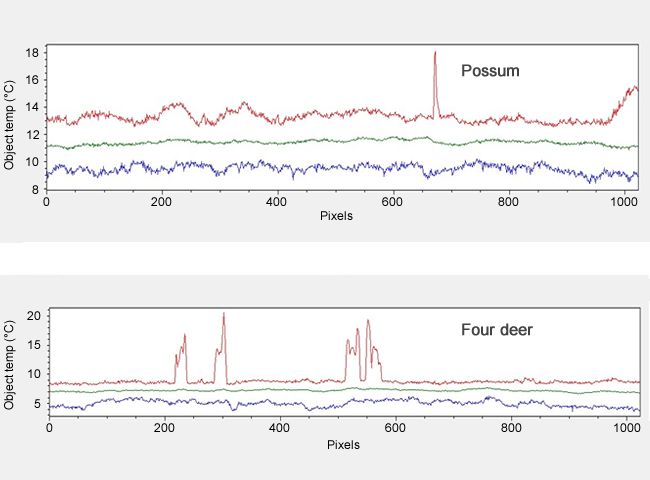Thermal imaging cameras for animal detection

Possum clearly visible by its heat signature
As with many technologies, thermal imaging cameras have been advancing rapidly over the past 10 years, with hunters, pest biologists and ecologists looking at their potential for detecting animal targets, pests and threatened species. Low-resolution thermal cameras cost $5,000–$10,000, but high-resolution cameras can cost more than $100,000. So before purchasing a thermal camera it is important to understand the limitations of the technology, and to be aware of the camera’s suitability for your target animal and the likely operating environment (e.g. in open or forested habitat, by day or by night, in a helicopter or drone, or travelling slowly or quickly).
Bruce Warburton and Ivor Yockney of Landcare Research, and Grant Halverson of Airborne Technologies, have been assessing the potential of using thermal cameras for detecting possums, wallabies, pigs and other species. Bruce’s team have been seeking a thermal camera that can be used in aerial surveys for detecting animals at very low densities, to determine whether a species has been eradicated from an area (i.e. not finding any animals, but being confident none have been missed). To be effective, aerial surveys need to achieve near total coverage, and the wider the aerial swath, the fewer the flight paths needed to cover an area. While the swath width can be increased by flying higher, the camera’s resolution is fixed, so increasing the height of the aircraft results in the camera’s pixel coverage of the ground growing proportionally larger, making it more difficult to detect and/or distinguish animals.
For example, using a camera with a 1024 × 768 pixel resolution and a fixed-focal-length lens of 30 mm, flying 300 m above the ground provides a swath of approximately 130 m. At this altitude an animal the size of a pig can be easily detected and identified, with approximately 13 pixels on the animal. However, using these same parameters would provide only 1–2 pixels coverage on an animal the size of a possum, rabbit or feral cat. To identify these smaller species with the same hardware requires flying at much lower altitudes, and this in turn results in a significantly narrower swath width and many more flight paths to cover the same area.
The technology is also limited by the frame rate of the camera (or Hertz rate) and the thermal response speed of each individual pixel. The aircraft speed, altitude and camera frame rate need to be optimised. Fast survey speeds at low altitudes create a blurring effect in the video, making it difficult to identify species, and a slow thermal pixel response also adds a smearing effect. Although more sophisticated research-grade thermal cameras with higher frame rates and faster pixel response speeds are available, they are prohibitively expensive for most uses (over $300,000).
An additional factor to consider is that thermal camera detectors operate at three different wavelengths – short, mid or long. Each wavelength has its advantages and disadvantages, depending on its application and the prevailing climate conditions. For applications in cooler environments, like New Zealand’s, long-wave thermal cameras produce better results, giving higher contrast between animals and their background, and they are less affected by solar glint than mid-wavelength cameras.
Some thermal imaging cameras are radiometric (they also display and record the absolute temperature of each individual pixel). Such raw radiometric data can be processed using proprietary software at a later date, and specific animal temperatures can be obtained.

Another critical issue associated with using thermal imaging to detect animals is obstruction by vegetation. Animals surrounded by vegetation and under forest canopy can sometimes be undetectable. However, there are often sufficient small gaps in the vegetation cover to allow an animal’s emitted energy to be detected from above. Pilot trials have revealed that scanning even heavily forested areas from multiple angles enables detection of ‘hot sites’, which can then be investigated more carefully to identify the source.
Larger species such as deer, goats, pigs and thar can be detected with lower-cost, less-high-specification cameras, but detecting small species such as possums and rabbits requires higher resolution and more sophisticated thermal cameras, especially if used in aerially based surveys. Bruce and his team are further testing thermal cameras for detecting wallabies and pigs, and comparing the cost-effectiveness of this technology with conventional methods such as dogs and visual inspections.
This work was funded by OSPRI and Landcare Research.
Bruce Warburton (Landcare Research) warburtonb@landcareresearch.co.nz
Ivor Yockney
Grant Halverson (Airborne Technologies)
